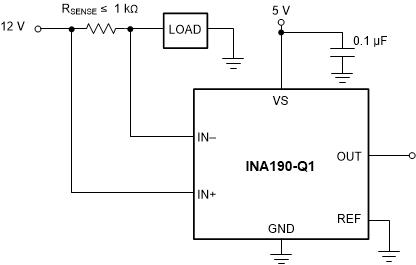SBOS871A May 2019 – March 2022 INA190-Q1
PRODUCTION DATA
- 1 Features
- 2 Applications
- 3 Description
- 4 Revision History
- 5 Pin Configuration and Functions
- 6 Specifications
- 7 Detailed Description
- 8 Application and Implementation
- 9 Power Supply Recommendations
- 10Layout
- 11Device and Documentation Support
- 12Mechanical, Packaging, and Orderable Information
Package Options
Mechanical Data (Package|Pins)
Thermal pad, mechanical data (Package|Pins)
Orderable Information
8.2 Typical Applications
The low input bias current of the INA190-Q1 allows accurate monitoring of small-value currents. To accurately monitor currents in the microamp range, increase the value of the sense resistor to increase the sense voltage so that the error introduced by the offset voltage is small. Figure 8-6 shows the circuit configuration for monitoring low-value currents. As a result of the differential input impedance of the INA190-Q1, limit the value of RSENSE to 1 kΩ or less for best accuracy.
 Figure 8-6 Microamp
Current Measurement
Figure 8-6 Microamp
Current Measurement